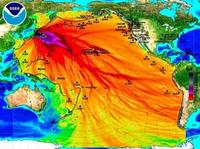-
NIST issues final Joplin tornado report
The National Institute of Standards and Technology (NIST) has released the final report on its technical investigation into the impacts of the 22 May 2011 tornado that struck Joplin, Missouri. The massive storm was the single deadliest tornado in the United States in the sixty years that official records have been kept. The NIST Joplin tornado study was the first to study scientifically a tornado in terms of four key aspects: storm characteristics, building performance, human behavior, and emergency communication — and then assess the impact of each on preventing injury or death.
-
-
Conflicting views hamper N.C. preparation for sea level rise
Residents of North Carolina’s coastal towns are finding themselves increasingly caught in the cross-fire between local and state government regarding how to define future sea level rise resulting from global warming and the necessary measures needed to prepare for it. Due to a four-year moratorium on any action on the state level, area developers and homeowners have received no official input, and the lack of consensus has negative consequences for the health and prosperity of the region.
-
-
Southeast England residents most at risk of rising deaths from climate change
Warmer summers brought on by climate change will cause more deaths in London and southeast England than the rest of the country, scientists predict. Researchers looked at temperature records and mortality figures for 2001 to 2010 to find out which districts in England and Wales experience the biggest effects from warm temperatures. In the most vulnerable districts, in London and the southeast, the odds of dying from cardiovascular or respiratory causes increased by over 10 percent for every 1C rise in temperature.
-
-
Ground-improvement methods to protect against earthquakes
Researchers are developing ground-improvement methods to help increase the resilience of homes and low-rise structures built on top of soils prone to liquefaction during strong earthquakes. Findings will help improve the safety of structures in Christchurch and the Canterbury region in New Zealand, which were devastated in 2010 and 2011 by a series of powerful earthquakes.
-
-
Climate change, population pressures leading to rethink of floating cities

The concepts have existed for decades, but governments and financiers, responding to the growing threat of rising tides, pollution, and overpopulation to coastal urban centers, are now beginning to take a more serious look at floating cities.
-
-
HHS proposes rules to govern health-care facilities’ disaster preparedness
The Centers for Medicare and Medicaid Services(CMS), a federal agency within the Department of Health and Human Services, has proposed new requirementsfor health-care facilities intended to ensure these facilities are prepared to care for patients during disasters. The regulations aim to prevent the service disruptions which occurred during Hurricane Sandy and Hurricane Katrina, when an estimated 215 deaths occurred in hospitals and nursing homes in Louisiana.
-
-
Linking extreme weather events to climate change a “distraction”: experts

Connecting extreme weather to climate change distracts from the need to protect society from high-impact weather events which will continue to happen irrespective of human-induced climate change, say experts. They suggest that developing greater resilience to extreme weather events must be given greater priority if the socioeconomic impact of storms, like those that have ravaged Britain this winter, is to be reduced.
-
-
Heat waves threaten global food supply

A new study has, for the first time, estimated the global effects of rising temperatures and elevated levels of carbon dioxide (CO2) on the production of maize, wheat, and soybean. Earlier studies have found that climate change is projected to reduce maize yields globally by the end of the century under a “business as usual” scenario for future emissions of greenhouse gases; however, this new study shows that the inclusion of the effects of heat waves, which have not been accounted for in previous modelling calculations, could double the losses of the crop.
-
-
Computer simulations help predict blast scenarios
Simulation-based engineering science (SBES) allows researchers to predict the effects of building explosions and analyze the response of building materials to those threats. Using a $400,000, five-year CAREER grant from the National Science Foundation, researchers developed the Material Point Method (MPM) a computer-generated tool which not only creates blast scenarios that informs blast and impact resistant materials and design, but also is crossing over into Hollywood animation — most recently, Disney’s Oscar-winning animated film, “Frozen.”
-
-
Planning for future ecological challenges
How can communities dodge future disasters from Mother Nature before she has dealt the blow? Researchers are taking a unique approach to the issue and gaining input and support from community stakeholders. Researchers conducted a series of one-on-one interviews at Big Hole Valley in Montana and Grand County in Colorado to get an array of community contributors thinking and planning for future ecological hazards, and to consider the impact of those decisions.
-
-
Storm surges, rising sea levels threaten New Jersey’s beach-centered tourism industry
Sea level at the Jersey Shore could rise by thirty-one inches by the year 2050, posing a threat to New Jersey’s $38 billion tourism industry. Experts say that the potential for more harsh storms and sea level rise calls for better promotion of what else New Jersey has to offer tourists aside from the beach.
-
-
NERC drill finds U.S. grid preparedness insufficient
The North American Electric Reliability Corporation (NERC) reported that its recent GridEx II exercise has highlighted the fact that nearly all the utilities which took part in the two-day drill last November – a drill aiming to test the preparedness of the U.S. power grid to withstand cyber and physical attacks – admitted that their planning for such attacks was insufficient. NERC’s president, Gerry Cauley, said that protecting utilities against cyber and physical attacks should be considered in the context of measures taken to protect the grid from other threats. He noted that utilities are already hardening their systems against storms like Hurricane Sandy, while working to determine their vulnerability to solar activity that changes the earth’s magnetic field.
-
-
U.S. infrastructure vulnerable to “cascading system failures” caused by weather disasters
Two U.S. government reports released last Thursday warn that U.S. infrastructure is vulnerable to the effects of climate change. One report focuses on energy, the second on infrastructure more generally. The infrastructure-focused report is the first attempt to review climate implications across all sectors and regions. The report analyzes how damage to one infrastructure sector can impact other infrastructure sectors, rather than isolating specific types of infrastructure. The authors warn that climate-fueled weather disasters could cause “cascading system failures” unless changes are adopted to minimize such effects.
-
-
NIST launches effort to improve disaster resilience of communities
The National Institute of Standards and Technology (NIST) will host the first of six workshops devoted to developing a comprehensive, community-based disaster resilience framework, a national initiative carried out under the President’s Climate Action Plan. The workshop will be held on Monday, 7 April 2014.
-
-
Radiation from Fukushima to reach West Coast in April

On the third anniversary of the Fukushima nuclear plant incident, scientists are reporting that low levels of radiation from the Fukushima plant will reach ocean waters along the U.S. West Coast by April 2014. The scientists say that the radiation will be at levels too low to harm humans, but they call for more monitoring, including at the federal level.
-
More headlines
The long view
Using Drone Swarms to Fight Forest Fires
Forest fires are becoming increasingly catastrophic across the world, accelerated by climate change. Researchers are using multiple swarms of drones to tackle natural disasters like forest fires.
How Climate Change Will Affect Conflict and U.S. Military Operations
“People talk about climate change as a threat multiplier,” said Karen Sudkamp, an associate director of the Infrastructure, Immigration, and Security Operations Program within the RAND Homeland Security Research Division. “But at what point do we need to start talking about the threat multiplier actually becoming a significant threat all its own?”
